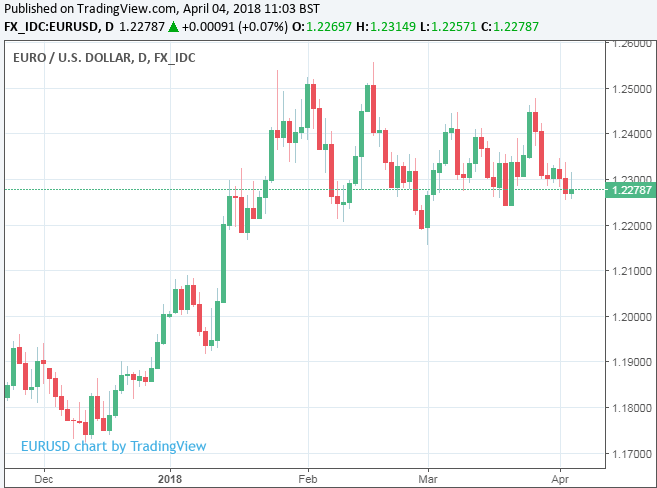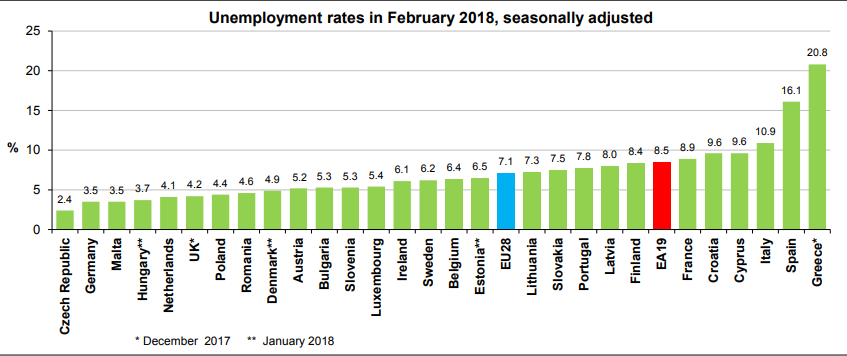Euro Shrugs Off Core-inflation Disappointment to Trade Higher Against Rivals
- Written by: James Skinner
-
-Headline inflation rises but core remains static in March.
-Food and energy prices drive change in headline rate.
-EUR/USD seen remaining trapped in recent range.

© Rawpixel.com, Adobe Stock
The Euro rose during early trading in London Wednesday as markets shrugged off a mixed set of inflation figures for March, which showed domestic price pressures remaining subdued on the continent during the recent month.
Headline inflation rose by 1.4% during March, up from 1.1% back in February and in line with market expectations, making for the joint highest level of the consumer price index since April 2017. Food, alcohol, tobacco and energy goods provided the greatest contribution to the uplift.
Core inflation, which removes volatile energy and food items from the goods basket and so is seen as more representative of domestically generated inflation pressures, surprised on the downside when the rate held steady at 1% for the month. Markets had been looking for a modest increase to 1.1%.
Services price inflation actually picked up a touch in March so the static core CPI number may have been the result of changes in non-energy industrial goods prices which, according to Eurostat, saw a much slower 0.2% increase during March. Prices of these goods had risen by 0.6% back in February.
"March’s rise in headline euro-zone consumer price inflation and the fall in the unemployment rate in February will reassure the ECB. But with core inflation unchanged at a low level, the Bank will continue to stress its patient and persistent approach to monetary policy normalisation," says Jessica Hinds, a European economist at Capital Economics.

Above: Eurostat graph showing sector inflation rates.
The Euro-to-Dollar rate was quoted 0.11% higher following the release while the Pound-to-Euro rate was 0.10% lower at 1.1445. Both rates are broadly unchanged from before the announcement, suggesting the Euro has taken the core inflation disappointment in its stride. Simultaneously, the Euro traded higher against all other G10 currencies barring the New Zealand Dollar and Japanese Yen.
Markets care about inflation data because the European Central Bank has made clear that it will only complete the winding down of its quantitative easing (bond buying) program when inflation shows signs of making a sustainable return to the 2% target. This matters for the Euro because when the ECB ceases its intervention in the bond markets, yields will be able to rise, which may then prove a powerful lure for international investors who would have to buy the single currency before they can invest in Eurozone bonds.
"Yields in the euro-zone have fallen notably of late, in large part due to global factors and ECB rhetoric emphasising the need for patience in reversing the current monetary stance. This has helped contain enthusiasm for the euro in the foreign exchange market with EUR/USD remaining in a relatively tight range of 1.2200-1.2500 over the same period," says Derek Halpenny, European head of global markets research at MUFG.

Above: EUR/USD rate shown at daily intervals.
The ECB said in December it will continue buying €30 billion of European bonds each month until “September 2018 or beyond”, with the final stoppage subject to developments around inflation. Until December it had been buying €60 billion or more each month in an effort to stoke consumer price pressures by spurring economic activity. QE is thought to do this by forcing down bond yields, which reduces borrowing costs for those in the real economy.
"Looking ahead, energy effects look set to push headline inflation back up towards the ECB’s near-2% target in the summer. But core inflation is likely to be much more subdued. Surveys of businesses’ and consumers’ inflation expectations point to core inflation picking up to only about 1.5% over the next year or so. And there is still plenty of slack in the region’s labour market," says Capital Economics' Hinds.
The European Central Bank is seen placing more emphasis on the still-low core inflation rate, rather than the headline number, when it comes to the deciding whether to finally end the bond buying program. This is because core inflation removes the effect of changes in energy prices, which are determined more by global factors than they are by Eurozone economic conditions.
"We believe there is certainly a high probability over the coming months that the annual CPI rate in the euro-zone accelerates close to the 2.0% inflation goal, which would imply the ECB is being too cautious with its 1.4% 2018 estimate. While the ECB may have an eye on core inflation, the official inflation target is the overall rate and a move higher will inevitably impact rate expectations," MUFG's Halpenny counters.
Beyond the rise in bond yields that would accompany an end to the ECB's quantitative easing program, markets care about developments around inflation because once the central bank ceases its intervention in financial markets its next move will be to raise interest rates. This would impact currency markets for exactly the same reasons as an end to quantitative easing, although on a much greater scale. Markets are currently looking for an initial interest rate rise in Europe around June 2019.

Above: Eurostat graph showing national unemploymetn rates across the European Union.
"It is likely to be some time before the labour market recovery generates meaningful domestic wage pressures across the region. Accordingly, the ECB will tread very cautiously in raising interest rates. We have pencilled in the first hike for September 2019, which is later than investors seem to expect," says Hinds.
Another factor that may complicate the ECB’s desire return to more normal monetary policy conditions, or hamper market expectations for Eurozone inflation further down the track, is a recent softening of economic momentum across the currency block. After all, the March IHS Markit PMI surveys of Europe’s key services and manufacturing industries all turned lower, receding from post-crisis highs.
GDP growth for the fourth quarter 2017 also came in a fraction slower than that seen in the third, leading economists to conclude that growth momentum may have already peaked in the Eurozone. This might pose a further challenge to those hoping inflation will rise further over coming months.
“This is unlikely to have an effect on the market’s medium term rate expectations though as the market only sees a likelihood of a rate hike next year anyway, says Esther Reichelt, an analyst at Commerzbank, referring to Wednesday's inflation data. "That is not only due to the continued low levels of inflation, most recently concerns about a cooling of the economic momentum...Without a healthy growth environment a rise of inflation towards the 2% target will become an ever more distant prospect."
Separately, and also on Wednesday, Eurostat data showed the Eurozone unemployment rate falling by 10 basis points to 8.5% during the February month, which is its lowest level since December 2008. This is down from the 9.5% rate of unemployment seen at the same time in 2017.
Greece and Spain still have the highest unemployment rates across the block at 20.8% and 16.1% respectively although Greece was one of the three countries to have seen the fastest fall in unemployment over the last year. In February 2017 Greek unemployment had been at 23.4%. Cyprus and Croatia both also saw large falls in jobless rates, which are now 9.6% in both countries.
Advertisement
Get up to 5% more foreign exchange by using a specialist provider to get closer to the real market rate and avoid the gaping spreads charged by your bank when providing currency. Learn more here.










